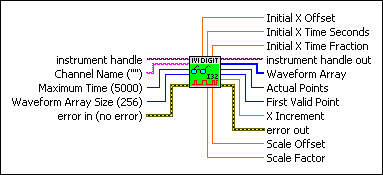IviDigitizer Read Waveform Int32
IviDigitizerBase Capability Group
This VI initiates an acquisition on the channels that the end-user configures with the IviDigitizer Configure Channel VI.
If the channel is not enabled for the acquisition, this VI returns Channel Not Enabled error. It then waits for the acquisition to complete, and returns the waveform for the channel the end-user specifies.
If the digitizer did not complete the acquisition within the time period the user specified with the Maximum Time parameter, the VI returns the Max Time Exceeded error.
 |
Note
|

 |
instrument handle The instrument handle that you obtain from the IviDigitizer Initialize VI or IviDigitizer Initialize With Options VI. The handle identifies a particular instrument session.
Default Value: None |
 |
Channel Name ("") Specifies the name of the channel from which to retrieve the data.
Default Value: "" Note: You can specify the trace name as a string variable or as a literal enclosed in double quotes. |
 |
Maximum Time (5000) Specifies the maximum time the end-user allows for this method to complete in milliseconds.
Unit: millisecond Default Value: 5000 |
 |
Waveform Array Size (256) Specifies the allocated size of the WaveformArray buffer, in number of data points.
If this value is smaller than the total number of points to be retrieved, the driver will fill the waveform buffer as fully as possible and return the actual number of points retrieved in the Actual Points parameter. Default Value: 256 |
 |
error in (no error) The error in cluster can accept error information wired from VIs previously called. Use this information to decide if any functionality should be bypassed in the event of errors from other VIs.
The pop-up option Explain Error (or Explain Warning) gives more information about the error displayed. |
 |
Initial X Offset The time in relation to the Trigger Event of the first point in the waveform in seconds. Negative values mean that the first point in the waveform array was acquired before the trigger event. |
 |
Initial X Time Seconds Specifies the seconds portion of the absolute time at which the first data point was acquired. Note that the actual time is the sum of Initial X Time Seconds and Initial X Time Fraction. The time is specified as the sum of two values because a single double-precision floating-point number does not have sufficient range and resolution to specify the time. |
 |
Initial X Time Fraction Specifies the fractional portion of the absolute time at which the first data point was acquired. Note that the actual time is the sum of Initial X Time Seconds and Initial X Time Fraction. The time is specified as the sum of two values because a single double-precision floating-point number does not have sufficient range and resolution to specify the time. |
 |
instrument handle out The instrument handle that you obtain from the IviDigitizer Initialize VI or IviDigitizer Initialize With Options VI. The handle identifies a particular instrument session.
Default Value: None |
 |
Waveform Array Buffer into which the acquired waveform is stored.
Notes: This array is always user allocated, and it must contain at least as many elements as the value you specify with the Number of Points parameter. |
 |
Actual Points Indicates how many data points were actually retrieved from the instrument. |
 |
First Valid Point Indicates the index of the first valid data point in the output Data array. This value will often be zero. However, some digitizer hardware designs transfer data most efficiently when the data is aligned with specific memory address boundaries. In those cases, the hardware may return a few invalid data points at the beginning of a record. This eliminates the need to shift the data during the transfer, ensuring maximum data transfer rates. |
 |
X Increment The time between points in the acquired waveform in seconds. |
 |
error out The error out cluster passes error or warning information out of a VI to be used by other VIs.
The pop-up option Explain Error (or Explain Warning) gives more information about the error displayed. |
 |
Scale Offset Scaling offset for the waveform data. |
 |
Scale Factor Scaling factor for the waveform data. |